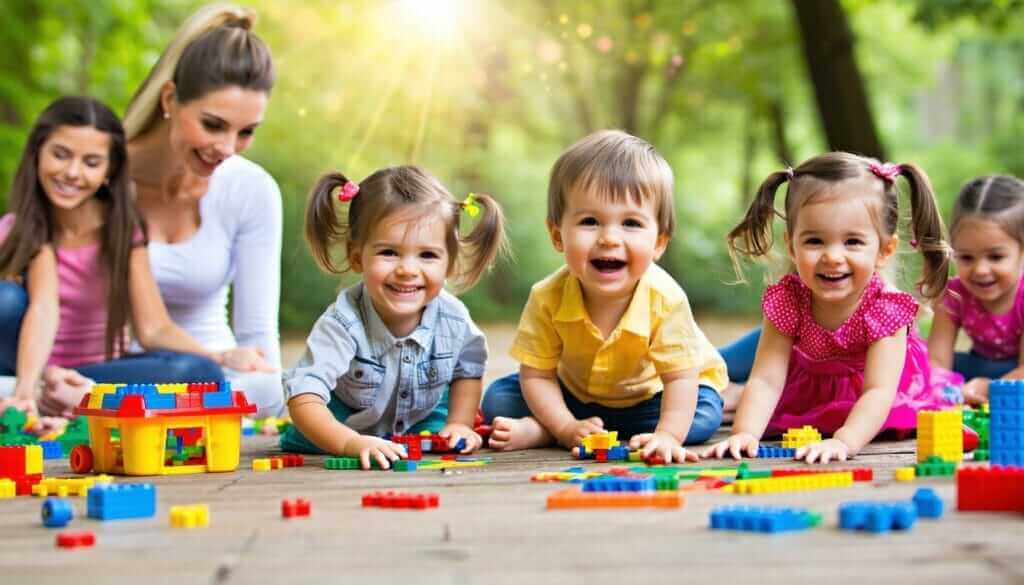Cultivating a Positive Mindset in Children
The Power of Positivity
Getting kids to see the sunny side of life is key to helping them grow up right. A can-do attitude can really perk up their heart and mind, improve how they get along with others, and even keep them healthier. By thinking positively, kids can bounce back quicker, handle stress better, and look forward to bright days ahead. Instead of seeing barriers, they see stepping stones and never feel like there’s no way out (thanks Alicia Ortega).
Make positivity a part of their daily grind by showing them how to solve problems rather than complain about them. Shifting how they see the world helps them keep going when the going gets tough. Toss in some feel-good self-talk every day to keep that positivity ball rolling.
| Perks of a Positive Perspective | What’s Included? |
|---|---|
| Happy Headspace | Boosts mood and bounces back quicker |
| Better Buddies | Ups skills for making and keeping friends |
| Fit as a Fiddle | Less stress, more health |
| Self-love Vibes | Builds a solid sense of self |
| Smarter Solutions | Turns problems into possibilities |
Benefits of Positive Thinking
Teaching your child to look on the bright side does way more than just make them feel good. It boosts their ability to handle tough times and grows them in all sorts of ways.
-
Emotionally Tougher: Kids learn to ride life’s rollercoaster smoothly. Cranking up their emotional muscles lets them tackle challenges head-on.
-
Friendlier Connections: A smiley outlook builds stronger bonds at home and in school. Kids open up more, work well with others, and learn to walk in someone else’s shoes.
-
Book Smarts & Beyond: Kids with happy thoughts do better at school. They aren’t afraid to tackle tough subjects and stay in the game.
-
Emotion Savvy: Getting a grip on feelings—inside and out—becomes second nature to these kids.
-
Motivational Mojo: When kids have a hopeful heart, aim high, and believe in possible victories, they chase their dreams.
-
Stress-Busting Boosters: With a glass-half-full mindset, handling life’s bumps becomes a breeze, making them stronger through trials.
Helping your child grasp the good feels of positivity molds their behavior and worldview. By wrapping them up in those warm, hopeful vibes early, you set the stage for them to grow into outgoing and hardy adults. Find more tips by checking out simple ways to grow positivity in kids and learn about nurturing optimism and persistence in young minds.
Impact of Positive Relationships
Jumping into the basics: good vibes amongst family and pals can do wonders for your kid’s noggin and behavior. Knowing how your family ticks and the friendships they form can set up a better scene at home for your little one.
Family Dynamics
Being on good terms with family members really boosts mental health and gives an overall good feeling. Families getting along better can cut down on stress and worry, create a homely feel, and boost self-pride. Some studies even show that a family that gels well can have a supercharged immune system.
Want tighter family ties? Try these pointers:
| Strategy | Description |
|---|---|
| Quality Time | Plan some fun family-only time. |
| Meaningful Conversations | Chat about their day, feelings, and cool stuff. |
| Affection and Warmth | Show love openly and often. |
By pulling off the above, you’re setting up a safe space where your kid can grow with a solid and sunny outlook on life. If you’re curious about boosting your child’s emotional smarts, see our detailed take on nurturing a positive mindset in child development.
Friendships and Social Health
Buddies play a big role in shaping emotional and social smarts. Good pals promote well-being by forming bonds, stirring motivation, and being a shoulder to lean on. These friendships also encourage healthy habits and keep the support flowing.
To help your kid make great friends, think about activities where they can hang out with peers comfortably such as:
- Team sports or other group fun.
- Playdates or guided activities.
- Local events or kids’ clubs.
Teaching your kid to be kind and understanding in friendships will level up their social game. For some tricks on instilling positivity and grit in kids, swing by our story on teaching children optimism and resilience.
Having a solid base of family and friend support is key to healthy development. This mix won’t just help behavior but builds the foundation for a bright, well-adjusted life.
Environment and Child Development
Where a kid grows up—everything from their community to how you’re parenting—shapes their attitude and behavior. A “can-do” mindset is like rocket fuel for their growth, helping them tackle life’s hurdles with confidence.
Societal Influences
There are so many things influencing kids these days: culture, money, and what’s going on in the community shape how your child feels and acts. Take families struggling with money, for example. Kids in these situations often have a hard time with school and making friends. This struggle can trickle down into their adult lives, messing with their job prospects and happiness (CPD Online College Ltd).
The way society treats kids can affect how they feel about themselves and their goals in life. Teaching them to keep their heads up despite societal pressures is super important. Activities focused on positive thinking can help your kid build a tough skin and a sunny outlook.
Parenting Styles
Your parenting style sets the stage for how your child grows up. Experts typically focus on four main types: authoritative, democratic, permissive, and neglectful. Each one guides your kid’s social skills and emotional growth differently.
| Parenting Style | Description | Impact on Child Behavior |
|---|---|---|
| Authoritative | Warm but firm | Builds self-confidence and success |
| Democratic | Teamwork and respect | Generally positive, but results can vary (PubMed) |
| Permissive | Laid-back and lenient | Potential social hiccups, some upsides (PubMed) |
| Neglectful | Not involved | Poor emotional and social outcomes |
Being a positive parent, especially if you’re following the authoritative style, tends to result in happier, more confident children. Showing care and laying down some rules helps children think positively and equips them for life’s challenges.
As a parent, you’re doing more than just laying down the law. You’re showing them how to stay positive and keeping those lines of communication open. Look into resources about teaching kids optimism and resilience, and encourage positive self-talk. These tools will help your child grow a strong and hopeful mindset.
Fostering Growth Mindset in Children
Strategies for Positive Thinking
Getting your kiddo to think positively is like handing them tools for a happier, more fulfilled life. Here’s how you can get the ball rolling:
-
Daily Affirmations: Start the day with some good vibes! Encourage your child to repeat simple positive phrases every day. Saying stuff like “I am capable” or “I’ve got what it takes” can light a little fire of confidence in them.
-
Spot the Solutions: When problems pop up, focus their attention on how to fix ’em instead of just worrying. Help them brainstorm ways around issues. You’ll be raising a little master of resilience and problem-solving. Who doesn’t love a good puzzle, right?
-
Be the Positivity You Want to See: Be like a living example of positivity. Let your kid see how you tackle life’s curveballs head-on and bounce back. They’ll learn that no mountain is too high if you approach it with grit and a smile.
-
Growth Everywhere: Surround your kid with stories, games, and activities that hammer home the message of growth. Make it clear that with effort, they can always get better than yesterday.
-
Celebrate the Hustle, Not Just the Trophy: Pat ’em on the back for hard work, even if they didn’t hit a home run. This way, they’ll learn that the journey is just as important as the destination, maybe even more!
Got the itch to learn more? Don’t miss our picks on positive thinking activities for kids to keep ’em giggling and growing.
Role of Effort and Persistence
Effort and persistence are the secret sauce when you’re trying to stir up a positive outlook in your kid. Here’s how you can make these superpowers shine:
-
Encourage Taking on the Tough Stuff: Push them gently into tackling challenges and stand by them. They’ll soon see that hard work often leads to getting better and learning loads.
-
Teach Them to Bounce Back: Turn setbacks into learning moments. Show them that failing isn’t fatal and quitting isn’t the path. Point them here for more on this lesson.
-
Spot the Progress: Help them keep tabs on their growth and accomplishments over time. Watching their own evolution will boost their belief that sticking with it pays off.
Here’s a handy dandy little table for a visual aid:
| Trait | What’s It Mean? | What’s the Payoff? |
|---|---|---|
| Effort | How much heart and focus they put into tasks | Leads to getting better and owning it |
| Persistence | Not quitting despite the roadblocks | Builds resilience and problem-solving chops |
| Growth Mindset | Belief that you can get better and stronger | Fuels lifelong curiosity and adaptability |
Blend these key bits into their everyday and watch as they blossom into upbeat little humans. Check out our guide on fostering a positive mindset in kids for more nuggets of wisdom.
Parental Influence on Mindset
Modeling Positivity
You’re the big cheese in your kid’s world, whether you believe it or not. Your actions and words set the stage for their mindset. By showing positivity, you’re planting the “Yes, I can!” seed in their heads. Kids are little copycats, picking up on how you deal with life. When you keep things sunny-side-up, they learn to tackle obstacles as if they’re puzzles to solve and not just brick walls. This way, they pick up resilience which is like a superhero mask for taking on life’s rollercoaster.
Studies have shown this: folks who think on the bright side tend to bounce back quicker from setbacks. Their brains and hearts stay healthier, with less of that anxiety business (Connections Academy). Sprinkle positive words and uplifting chats into your daily routine, and watch your kid’s emotional and mental gears start spinning smoother.
Want some pro tips? Take a seat and chat about your own cool adventures and how you handled the rough patches. Share stories that shine a light on your problem-solving ninja skills, which can motivate your little one to walk a similar path.
Encouraging Resilience
Bolstering resilience in your kiddo is like giving them a treasure map for their emotional island. A kid with resilience in their toolkit can brush off stress, face down challenges, and approach life with a hopeful spirit. To amp up this trait, highlight the power of trying hard and sticking with it. Cheer for their wins and also for their attempts, reminding them that failure’s just a ladder to success.
Let your young one know that life’s hiccups are part of the gig. Teach them to flip the switch from negative thinking to positive vibes—the kind of trick that can make handling bumps in the road a cinch. Try some fun activities, like positive thinking games for children, to boost this life hack.
Create a warm environment where your child knows it’s cool to let out how they’re feeling. Encourage them to spill about their emotions, assuring them it’s perfectly fine to feel blue or ticked off sometimes. This not only sharpens their emotional smarts but also lays down a solid path for a positive mindset.
By offering ways and exploring guides on teaching kids optimism and resilience, you’re crafting a solid game plan for navigating life’s twists and turns. Help your kid build up their resilience and positivity, opening up a toolbox for life’s challenges, and paving the way for a sunny outlook that sticks with them as they grow.
Positive Thinking Practices
Growing a positive mindset in kids is like planting tiny seeds of happiness that sprout into lifelong habits. Here, we dig into practices that light up their minds like optimism and goal-setting.
Promoting Optimism
When kids think on the bright side, they become little warriors, ready to tackle any challenge without flinching. It’s like turning on a solution-oriented superpower (Alicia Ortega). Methods like these help sprinkle positivity:
| Activity | Purpose |
|---|---|
| Acts of Kindness | Kindness is contagious and it’s really a two-for-one deal: doing good lifts their spirits while teaching empathy. Giving back boosts both mood and self-worth. |
| Loving-Kindness Meditation | This involves focusing on love and kindness, spreading good vibes, and getting those social ties tighter than ever (BigLifeJournal). |
By getting into these habits, you help your child develop an upbeat outlook, which is golden for good talks and steady emotions.
Goal Setting and Visualization
Setting goals is like handing your child a map for their dreams – it’s the start of a thrilling adventure. When kids learn to set targets and picture themselves winning, they get a boost of feel-good vibes. Try the WOOP strategy: Wish, Outcome, Obstacle, Plan. It teaches them to foresee hiccups and tackle them head-on.
| WOOP Component | Description |
|---|---|
| Wish | Spot a cool goal your kiddo is excited about. |
| Outcome | Get them to picture the joy of nailing it, fueling their enthusiasm. |
| Obstacle | Spot potential bumps in the road ahead. |
| Plan | Sketch out a game plan to tackle those hurdles. |
Visualization cranks up their confidence, making learning and life’s challenges less daunting. These tools set them up with the right attitude, a real game-changer in how they behave and evolve.
Adding these tricks into your child’s daily rhythm boosts resilience and positivity, essential ingredients for a happy life. For more insights, hop over to our pieces on guiding kids in optimism and resilience and fun positivity-building activities for children.




